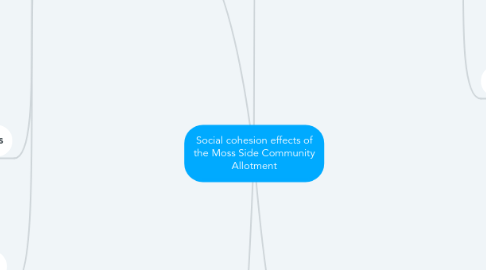
1. Methodology
1.1. potential data collecting methods
1.1.1. primary collection
1.1.1.1. interviews
1.1.1.1.1. questionnaires
1.1.1.2. ethnography
1.1.1.2.1. start volunteering at the garden
1.1.1.3. textual methods
1.1.1.3.1. visual methods
1.1.1.4. video or phone interviews
1.1.2. secondary collection
1.1.2.1. Manchester City Council
1.1.2.2. Moss Side Community Allotment webpage or Facebook group
1.1.2.3. general community garden data in the area
1.1.2.3.1. Sow the city
1.1.2.4. leaflets and impact statements
1.2. potential ethical problems
1.2.1. interviews
1.2.1.1. coercion of interviewee
1.2.1.2. language barriers
1.2.2. enthography
1.2.2.1. researcher may not be welcome in certain spaces
1.2.2.2. money is saved by the users on buying fresh produce
1.2.2.3. failure to recognise differences
1.2.2.4. potential to seem like researcher is just observing- as if the people are not people
1.3. potential health and safety problems
1.3.1. outdoor interviews could be dangerous- gardening equipment
1.3.2. ensure the groups of people are aware the researcher is coming
1.3.3. ensure parents know the researcher will be there if there are children
1.4. ensure to carry out a risk assessment
1.4.1. make sure it is approved by the institution
1.4.2. include ethical issues
1.4.3. include solutions or actions to potential problems
2. Links to academic writing
2.1. methodology
2.1.1. Cochrane 2014
2.1.1.1. Dunn 2016
2.1.1.1.1. Longhurst 2016
2.2. similar studies
2.2.1. Glover 2005
2.2.1.1. study about how community gardens create relationships between areas in large cities
2.3. Background of manchester as a city
2.3.1. industrial revolution
2.3.1.1. Rodgers 1962
2.3.2. economic differences
2.3.3. one of the largest cities in the UK
2.3.3.1. large econmic differences
2.3.3.2. aiming to be carbon neutral by 2030
3. Geographic field links
3.1. social geographies
3.1.1. interaction of people and place
3.1.2. connection to place and identity
3.2. health geographies
3.2.1. mental health
3.2.1.1. outdoor spaces providing therapeutic spaces
3.2.1.2. spaces for friendship and companionship
3.2.1.3. sense of purpose- particularly for unemployed people
3.2.1.4. green spaces connects us with nature- boosting serotonin and happiness
3.2.2. physical health
3.2.2.1. exercise from gardening
3.2.2.2. encourages higher consumption of fruit and vegetables
3.2.2.3. green city spaces reduce air pollution
3.3. economic geographies
3.3.1. reduces risk of health complications- saving money on healthcare
3.4. environmental geographies
3.4.1. lowers community carbon foot print
3.4.1.1. reduces air miles of food
3.4.1.2. reduces need to food over seas as seasonal food is produced
3.4.1.3. green spaces in cites sequester carbon dioxide
3.4.2. education about climate change
4. Aims and questions
4.1. explore if there have been positive impacts
4.1.1. should the findings be shared with the community garden for improvements or marketing?
4.1.2. do they impact all demographics
4.1.2.1. Is there diversity in the types of people that benefit from the project?
4.2. does the project keep its regular volunteers?
4.2.1. high retention symbolises enjoyment and benefit
4.2.2. do volunteers continue to return and enjoy working on the project?
4.3. how does the project get new volunteers
4.3.1. only through social media?
4.3.1.1. does this limit the project to a younger generation?
4.3.2. leaflets?
4.3.2.1. do these go through doors or just in specific areas?
4.3.3. is sufficient outreach done to enrol the most vulnerable of people?

